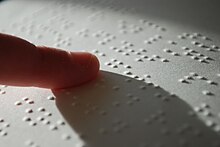 Global Information
Global InformationBraille information
The examples and perspective in this article deal primarily with the English-speaking world and do not represent a worldwide view of the subject. (June 2022) |
| Braille | |
|---|---|
 | |
| Script type | Alphabet
(nonlinear) |
| Creator | Louis Braille |
Time period | 1824–present |
| Direction | Left-to-right |
| Languages | 133 languages |
| Related scripts | |
Parent systems | Night writing
|
Child systems | See Category:French-ordered braille alphabets |
Sister systems | New York Point |
| ISO 15924 | |
| ISO 15924 | Brai (570), Braille |
| Unicode | |
Unicode alias | Braille |
Unicode range | U+2800–U+28FF |
Braille (/breɪl/ BRAYL, French: [bʁɑj]) is a tactile writing system used by people who are visually impaired. It can be read either on embossed paper or by using refreshable braille displays that connect to computers and smartphone devices. Braille can be written using a slate and stylus, a braille writer, an electronic braille notetaker or with the use of a computer connected to a braille embosser.
Braille is named after its creator, Louis Braille, a Frenchman who lost his sight as a result of a childhood accident. In 1824, at the age of fifteen, he developed the braille code based on the French alphabet as an improvement on night writing. He published his system, which subsequently included musical notation, in 1829.[1] The second revision, published in 1837, was the first binary form of writing developed in the modern era.
Braille characters are formed using a combination of six raised dots arranged in a 3 × 2 matrix, called the braille cell. The number and arrangement of these dots distinguishes one character from another. Since the various braille alphabets originated as transcription codes for printed writing, the mappings (sets of character designations) vary from language to language, and even within one; in English Braille there are 3 levels of braille: uncontracted braille – a letter-by-letter transcription used for basic literacy; contracted braille – an addition of abbreviations and contractions used as a space-saving mechanism; and grade 3 – various non-standardized personal stenography that is less commonly used.
In addition to braille text (letters, punctuation, contractions), it is also possible to create embossed illustrations and graphs, with the lines either solid or made of series of dots, arrows, and bullets that are larger than braille dots. A full braille cell includes six raised dots arranged in two columns, each column having three dots.[2] The dot positions are identified by numbers from one to six.[2] There are 64 possible combinations, including no dots at all for a word space.[3] Dot configurations can be used to represent a letter, digit, punctuation mark, or even a word.[2]
Early braille education is crucial to literacy, education and employment among the blind. Despite the evolution of new technologies, including screen reader software that reads information aloud, braille provides blind people with access to spelling, punctuation and other aspects of written language less accessible through audio alone.
While some have suggested that audio-based technologies will decrease the need for braille, technological advancements such as braille displays have continued to make braille more accessible and available. Braille users highlight that braille remains as essential as print is to the sighted.[4]
- ^ Braille, Louis (1829). Method of Writing Words, Music, and Plain Songs by Means of Dots, for Use by the Blind and Arranged for Them.
- ^ a b c "The Dot Positions in the braille cell Are Identified by Numbers from One Through Six". AFB.org. Archived from the original on 8 March 2019. Retrieved 19 June 2016.
- ^ "Louis Braille and the Braille System". duxburysystems.com. Archived from the original on 16 August 2018. Retrieved 16 August 2018.
- ^ World Blind Union. "Press Release: The importance of Braille Literacy". The International Agency for the Prevention of Blindness. Archived from the original on 1 December 2021. Retrieved 1 December 2021.